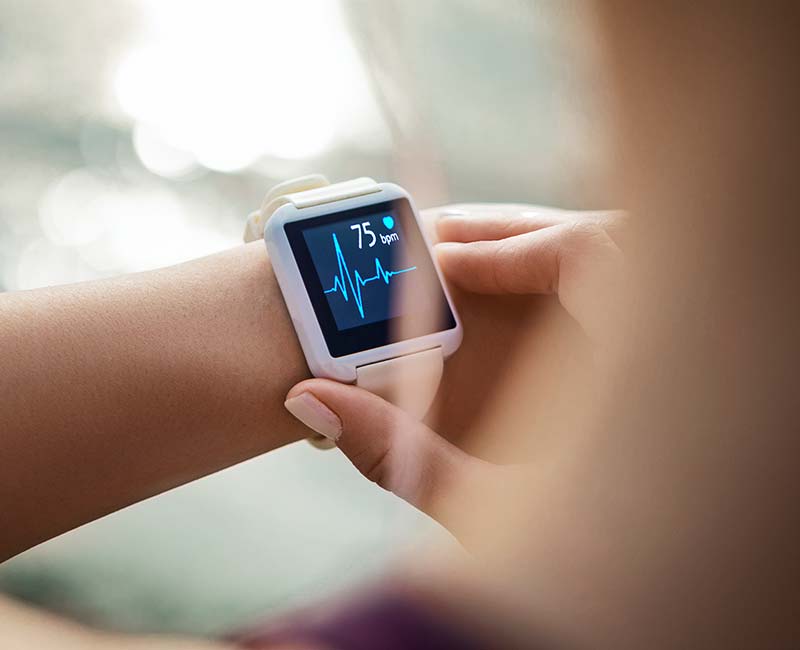Heart rate monitors are devices that can detect and track your heart or pulse rate continuously. Most of these devices are wearable, and many are highly accurate. While these devices can be valuable tools in monitoring your health, they aren't as accurate as approved medical devices, and you shouldn’t use them in place of medical care.
Advertisement
Cleveland Clinic is a non-profit academic medical center. Advertising on our site helps support our mission. We do not endorse non-Cleveland Clinic products or services. Policy

Heart rate monitors are devices that detect and measure your heart or pulse rate. Thanks to advances in technology, these devices are small, wearable and many use sensors that are very accurate. However, while these devices are excellent for personal use, they’re no substitute for medical devices that are much more accurate.
Advertisement
Cleveland Clinic is a non-profit academic medical center. Advertising on our site helps support our mission. We do not endorse non-Cleveland Clinic products or services. Policy
Heart rate monitors are very popular features in wearable devices like smartwatches and fitness trackers. Many of these devices also connect wirelessly to smartphones and computers. That allows users easy access to review their heart rate data. Heart rate monitors see common use for the following purposes:
Heart rate monitors in wearable devices are available to anyone who wants to buy one. You can buy them at many different stores and online retailers.
Your pulse and heart rate are two different ways to track your heart’s activity. Your heart rate is how many times your heart beats per minute. Your pulse rate is how many times per minute your arteries expand because of your heart beating.
There’s usually no difference between your heart rate and your pulse rate (or the difference is very small). However, certain health conditions, medications or circumstances can make the pulse in your arms harder to detect. That can interfere with the way these devices work.
The term "heart rate monitor" refers to devices that can detect either your heart rate or your pulse rate. These devices use two different approaches:
Advertisement
Device accuracy generally depends on the device's type of detection and the user’s activity while wearing the device.
Advertisement
Depending on the type of device, you may need to use them differently. Some you wear around your wrist or forearm. Others are rings you wear on a finger. The chest-strap devices have their sensors in the strap. Depending on the mode, some connect with a cable or wirelessly to a device that you can clip onto your clothing or you can carry in a pocket, and many of the newer models use wireless connections to your phone or another device. To learn the best way to use your device and get the most accurate results, be sure to read the instruction manual completely. Most of these devices also have websites with user forums, where you can ask questions and share information about how these devices can best help you.
The risks of using heart rate monitors are very minimal. For the most part, the greatest concern is an allergy you might have to some of the materials that make up the band or the device itself.
However, just because these devices are safe to use doesn’t mean they’re a substitute for officially approved medical devices. If you have health concerns that need monitoring, the safest and most accurate devices are those that have approval from the U.S. Food & Drug Administration (or from the appropriate regulatory agency in your country). That approval means these devices meet strict quality and accuracy standards and that they're ideal for medical use.
Advertisement
Depending on the device you’re using, the results might have slightly different meanings.
Regardless of whether or not they measure your heart rate or your pulse rate, the results try to convey the same thing: How many times your heart beats per minute. Depending on the device, they may also measure and display other metrics, like heart rate variability. Some also use apps that offer you that data in ways that you can tailor to your uses and needs.
These devices track your heart or pulse rate while you wear them. Seeing your results should be as easy as looking at the device itself or the associated app on your smartphone.
You should call your healthcare provider if you notice that your heart rate is unusually fast or slow. For adults, that means slower than 60 beats per minute (bradycardia) or faster than 100 beats per minute while you’re resting (tachycardia).
You should also call your healthcare provider if you experience any symptoms of an irregular heart rhythm (arrhythmia), especially heart palpitations. This symptom is the ability to feel your heart beating without trying, and it’s usually an unpleasant feeling. It can also feel like your heart is pounding, flip-flopping or skipping beats.
Advertisement
You should go to the hospital if you have any symptoms of a heart attack or other serious heart problem. Those include the symptoms of arrhythmias, heart palpitations, or the following:
Heart rate monitors are a useful and accessible tool to help you track your heart’s activity. Depending on the device you pick, you can access a wide range of information and data. That data can help you improve your health, create and manage an exercise plan and more. However, heart rate monitors aren’t a substitute for regular visits with a healthcare provider, especially if you think you might have a problem. You can also talk to your healthcare provider about recommendations on how you can use these devices to benefit you and how you can work smarter — not just harder — on taking care of yourself.
Cleveland Clinic’s primary care providers offer lifelong medical care. From sinus infections and high blood pressure to preventive screening, we’re here for you.

Last reviewed on 07/05/2022.
Learn more about the Health Library and our editorial process.